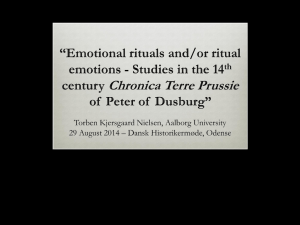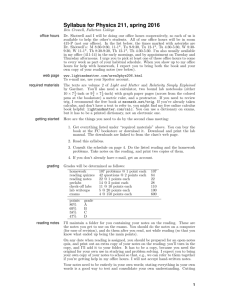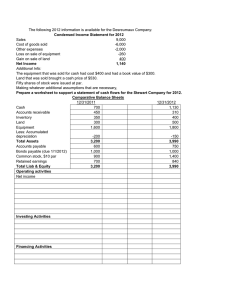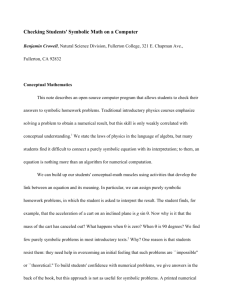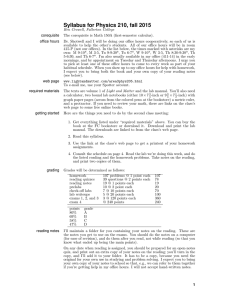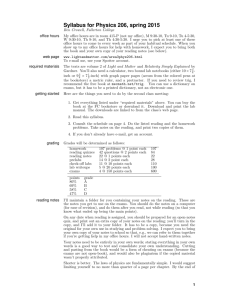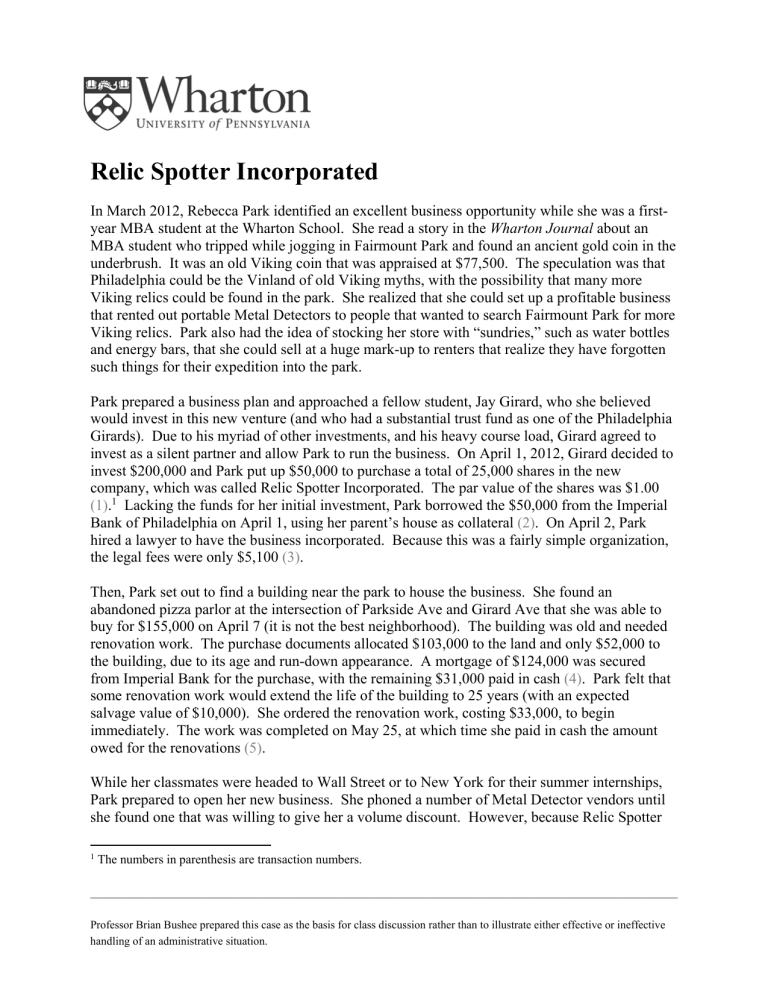
Relic Spotter Incorporated In March 2012, Rebecca Park identified an excellent business opportunity while she was a firstyear MBA student at the Wharton School. She read a story in the Wharton Journal about an MBA student who tripped while jogging in Fairmount Park and found an ancient gold coin in the underbrush. It was an old Viking coin that was appraised at $77,500. The speculation was that Philadelphia could be the Vinland of old Viking myths, with the possibility that many more Viking relics could be found in the park. She realized that she could set up a profitable business that rented out portable Metal Detectors to people that wanted to search Fairmount Park for more Viking relics. Park also had the idea of stocking her store with “sundries,” such as water bottles and energy bars, that she could sell at a huge mark-up to renters that realize they have forgotten such things for their expedition into the park. Park prepared a business plan and approached a fellow student, Jay Girard, who she believed would invest in this new venture (and who had a substantial trust fund as one of the Philadelphia Girards). Due to his myriad of other investments, and his heavy course load, Girard agreed to invest as a silent partner and allow Park to run the business. On April 1, 2012, Girard decided to invest $200,000 and Park put up $50,000 to purchase a total of 25,000 shares in the new company, which was called Relic Spotter Incorporated. The par value of the shares was $1.00 (1).1 Lacking the funds for her initial investment, Park borrowed the $50,000 from the Imperial Bank of Philadelphia on April 1, using her parent’s house as collateral (2). On April 2, Park hired a lawyer to have the business incorporated. Because this was a fairly simple organization, the legal fees were only $5,100 (3). Then, Park set out to find a building near the park to house the business. She found an abandoned pizza parlor at the intersection of Parkside Ave and Girard Ave that she was able to buy for $155,000 on April 7 (it is not the best neighborhood). The building was old and needed renovation work. The purchase documents allocated $103,000 to the land and only $52,000 to the building, due to its age and run-down appearance. A mortgage of $124,000 was secured from Imperial Bank for the purchase, with the remaining $31,000 paid in cash (4). Park felt that some renovation work would extend the life of the building to 25 years (with an expected salvage value of $10,000). She ordered the renovation work, costing $33,000, to begin immediately. The work was completed on May 25, at which time she paid in cash the amount owed for the renovations (5). While her classmates were headed to Wall Street or to New York for their summer internships, Park prepared to open her new business. She phoned a number of Metal Detector vendors until she found one that was willing to give her a volume discount. However, because Relic Spotter 1 The numbers in parenthesis are transaction numbers. ________________________________________________________________________________________________________ Professor Brian Bushee prepared this case as the basis for class discussion rather than to illustrate either effective or ineffective handling of an administrative situation. Relic Spotter Corporation was a new business, the vendor required her to pay the full balance in cash immediately. On June 2, Park purchased 240 Metal Detectors at an average cost of $500 per unit. The innovation in the Metal Detector industry is so rapid that Park felt the units would only last for two years, at which time they would have no remaining value (6). On June 15, Park ordered $2,000 of sundries inventory (e.g., water bottles, energy bars, etc.) to be delivered on June 30. Park was able to purchase the inventory “on account”, which meant she had up to 30 days after delivery to pay the supplier (7). With the business set to open the next day, Park was very busy on June 30. First, she paid $700 for a site license to use geo-contour mapping software in the Metal Detectors. The license was good for three-years with $700 due to be paid annually (i.e., the total cost over three-years will be $2,100) (8). Next, Park signed a contract with a local advertising agency to provide various forms of advertising for a period of one year. She paid $8,000 upfront for advertising through June 2013 (9). Then, Park needed cash to make a payment on the Imperial Bank loan that funded her purchase of Relic Spotter stock. She borrowed $5,000 from Relic Spotter at 10% interest, with the principal and interest due in a lump sum on June 30, 2013 (10). Park also hired two employees, Linda Carlyle and Charlotte Cafferly, to run the shop. They signed employment contracts promising each salaries of $32,000 per year (11). On the night of June 30, just hours before the Grand Opening, Girard called Park from St. Tropez to check in on the business. Upon hearing that Relic Spotter only had $47,200 of cash left in the bank, Girard became concerned about his investment. Thinking fast, Park stated that she was so confident of Relic Spotter’s prospects that she was declaring a $0.10 per share dividend, to be paid on August 31 (12). This dividend seemed to reassure Girard. Relic Spotter opened for business on July 1, 2012, just in time for the big Independence Day weekend. On July 31, Park paid the supplier the $2,000 it was owed (13). On August 31, Park paid the dividend that had been declared in June (14). In a search for new revenue opportunities, Park initiated an experimental unlimited rental arrangement with the Penn Antiquities Club on December 1. Under this arrangement, the club paid Relic Spotter $1,200 cash upfront for unlimited rentals over the next year (15). For the six months ended December 31, 2012, rental revenues on the Metal Detectors totaled $124,300. Due to the nature of the business, most of the rentals were cash sales. However, as an initiative to reward repeat customers, Park allowed a select number of frequent renters to charge their rentals and be billed later. As of December 31, 2012, $4,200 was outstanding under this plan (16). During the period between July 1 and December 31, Park purchased $40,000 of sundries inventory, of which $38,000 had been paid in cash and $2,000 was still owed at December 31 (17). Relic Spotter recorded sales of sundries totaling $35,000 this period, all received in cash (18). The original cost of these sundries was $30,000 (19). Finally, Relic Spotter’s two employees were paid wages of $32,000 during this six-month period and Park drew a salary of $50,000 (20). T HE W HARTON S CHOOL OF THE U NIVERSITY OF P ENNSYLVANIA 2 Relic Spotter Corporation When Park called her accountant on December 31, 2012, she was pleased to tell him that the company had $79,000 in cash. She wanted to go out to celebrate, but the accountant reminded her that she needed to stay in to do adjusting entries. For example, even though it wasn’t paid in cash, accrued interest on the mortgage was $4,900 (21). Also, “depreciation” would have to be recorded on the building (Park was confused by this because she received an unsolicited letter from a mortgage broker informing her that the building had increased in value to $120,000) (22) and on the Metal Detectors (23). Finally, after adjusting the software amortization account (24), prepaid advertising account (25), notes receivable account (26), and unearned revenue account (27), there would be income tax expense of $630 (Park was also confused by this because she did not do her taxes until April) (28). The accountant also reminded her that they would need to prepare a set of financial statements to provide Girard, as well as Imperial Bank and any prospective investors, a relevant and reliable picture of Relic Spotter’s financial position and results of operations. Park vaguely remembered hearing something about this in Accounting 603 at Wharton, but would definitely need some help! Using the Exhibits on the following pages, please do the following: 1. Record journal entries for all transactions up to the “Meeting with the Accountant” in the general journal (Exhibit 1) 2. Posting these journal entries to the T-accounts (Exhibit 2) 3. Complete the unadjusted trial balance worksheet (Exhibit 3) 4. Record all adjusting entries, post to T-accounts, and complete the adjusted trial balance worksheet 5. Record all closing entries and prepare the Income Statement for the year ended December 31, 2012 (Exhibit 4) 6. Prepare the Balance Sheet for December 31, 2012 (Exhibit 5) T HE W HARTON S CHOOL OF THE U NIVERSITY OF P ENNSYLVANIA 3 Relic Spotter Corporation Exhibit 1: General Ledger No. (1) Date 4/1/2012 Accounts T HE W HARTON S CHOOL OF THE U NIVERSITY OF P ENNSYLVANIA Debits Credits 4 Relic Spotter Corporation Exhibit 1 (continued): General Ledger No. Date Accounts T HE W HARTON S CHOOL OF THE U NIVERSITY OF P ENNSYLVANIA Debits Credits 5 Relic Spotter Corporation Exhibit 2: T-accounts Cash (A) Land (A) Dividends Payable (L) Buildings (A) Inc. Taxes Payable (L) Metal Detectors (A) Unearned Rental Rev. (L) Accounts Receivable (A) Acm. Depreciation (XA) Mortgage Payable (L) Notes Receivable (A) Software (A) Common Stock (SE) Interest Receivable (A) Accounts Payable (L) Add’l Paid-in-Cap. (SE) Interest Payable (L) Retained Earnings (SE) Inventory (A) Prepaid Advertising (A) T HE W HARTON S CHOOL OF THE U NIVERSITY OF P ENNSYLVANIA 6 Relic Spotter Corporation Exhibit 2: (continued): T-accounts Sales (R) Legal Fee Exp. (E) Interest Expense (E) Rental Revenue (R) Advertising Exp. (E) Income Tax Exp. (E) Interest Revenue (R) Bldg Depreciation Exp. (E) Cost of Goods Sold (E) Met. Det. Depr. Exp. (E) Salary & Wages Exp. (E) Software Amortization (E) T HE W HARTON S CHOOL OF THE U NIVERSITY OF P ENNSYLVANIA 7 Relic Spotter Corporation Exhibit 3: Trial Balance Worksheet Accounts Cash Accounts Receivable Notes Receivable Interest Receivable Inventory Prepaid Advertising Land Buildings Metal Detectors Accum. Depreciation Software Unadjusted Balances Debit Credit Adjustments Debit Credit Adjusted Balances Debit Credit Accounts Payable Interest Payable Dividends Payable Income Taxes Payable Unearned Rental Rev Mortgage Payable Common Stock Add’l Paid-in-Capital Retained Earnings Rental Revenue Sales Interest Revenue Cost of Goods Sold Salaries & Wages Exp Legal Fees Expense Advertising Expense Bldg. Depreciation Exp Met. Det. Depr. Exp. Software Amortization Interest Expense Income Tax Expense T HE W HARTON S CHOOL OF THE U NIVERSITY OF P ENNSYLVANIA 8 Relic Spotter Corporation Exhibit 4 Relic Spotter Corporation Income Statement For the year ended December 31, 2012 Revenues: Rental Revenue Sales Total Revenue Cost of Revenues: Metal Detector Depreciation Expense Software Amortization Cost of Goods Sold Total Costs of Revenue Gross Profit Selling, General, and Administrative Expenses: Salaries and Wages Legal Fees Advertising Bldg. Depreciation Total SG&A Expenses Operating Income Interest Revenue Interest Expense Pre-tax income Income Tax Expense Net Income T HE W HARTON S CHOOL OF THE U NIVERSITY OF P ENNSYLVANIA 9 Relic Spotter Corporation Exhibit 5 Relic Spotter Corporation Balance Sheet December 31, 2012 Assets Cash Accounts Receivable Notes Receivable Interest Receivable Inventory Prepaid Advertising Total Current Assets Land Buildings Metal Detectors Less Accumulated Depreciation Net Property, Plant, & Equipment Software Total Assets Liabilities and Shareholders' Equity Accounts Payable Interest Payable Income Taxes Payable Unearned Rental Revenue Total Current Liabilities Mortgage Payable Total Liabilities Common Stock Additional Paid-in-Capital Retained Earnings Total Shareholders' Equity Total Liabilities and Shareholders' Equity T HE W HARTON S CHOOL OF THE U NIVERSITY OF P ENNSYLVANIA 10


